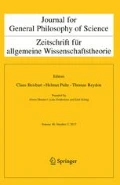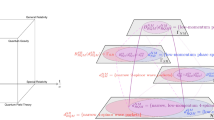Abstract
This paper proposes a classification of the intertheoretic relations in physics by bringing out the conditions for a relation of reduction which is eliminative, so that a theory reduced in terms of reductionism is superfluous in principle, and by distinguishing such a relation from another one based on comparison, which will be called neighbourhood of theories; the latter is a neighbouring relation between theories and is not able to support claims of eliminative reductionism. In the first part, it will be argued that this differentiation between neighbourhood and eliminative reduction permits an adequate classification of the intertheoretic relations in physics. By means of this differentiation, the second part discusses reductionism and shows that there are indeed some historical examples of reduction in the aforementioned sense, but that modern physical theories are typically only neighbouring.
Similar content being viewed by others
References
Bacciagaluppi, G. (2012). The role of decoherence in quantum mechanics. In E. N. Zalta (Ed.), The stanford encyclopedia of philosophy (Sommer 2012 edition). Retrieved Nov 10, 2012, from http://plato.stanford.edu/archives/sum2012/entries/qm-decoherence/.
Batterman, R. W. (2002). The devil in the details: asymptotic reasoning in explanation, reduction, and emergence. New York: Oxford University Press.
Batterman, R. W. (2012). Intertheory relations in physics. In E. N. Zalta (Ed.), The Stanford Encyclopedia of Philosophy (Fall 2012 Edition). Retrieved Nov 10, 2012, from http://plato.stanford.edu/archives/fall2012/entries/physics-interrelate/.
Bickle, J. (1998). Psychoneural reduction: The new wave. Cambridge, MA: The MIT Press.
Bickle, J. (2006). Ruthless reductionism in recent neuroscience. IEEE Transactions on Systems, Man, and Cybernetics, 36, 134–140.
Callender, C. (2001). Taking thermodynamics too seriously. Studies in the History and Philosophy of Modern Physics, 32(4), 539–553.
Endicott, R. (2001). Post-structuralist Angst–Critical notice: John Bickle, psychoneural reduction: The new wave. Philosophy of Science, 68(3), 377–393.
Feyerabend, P. K. (1962). Explanation, reduction, and empiricism. In H. Feigl & G. Maxwell (Eds.), Scientific explanation, space, and time (pp. 28–97). Minneapolis: University of Minnesota Press.
Gutschmidt, R. (2009). Einheit ohne Fundament. Eine Studie zum Reduktionsproblem in der Physik. Ontos: Frankfurt am Main.
Hellman, G. (1999). Reduction(?) to what? Philosophical Studies, 95, 203–214.
Hooker, C. A. (1981). Towards a general theory of reduction. Part I-III’. Dialogue, 20, 38–59, 201–236, 496–529.
Joos, E. (1996). Introduction. In D. Giulini, E. Joos, C. Kiefer, J. Kupsch, I.-O. Stamatescu, & H. D. Zeh (Eds.), Decoherence and the appearance of a classical world in quantum theory (pp. 1–3). Berlin, Heidelberg, New York: Springer.
Kemeny, J., & Oppenheim, P. (1956). On reduction. Philosophical Studies, 7, 6–19.
Krips, H. (2007). Measurement in quantum theory. In E. N. Zalta (Ed.), The stanford encyclopedia of philosophy (Fall 2008 edition). Retrieved March 14, 2011, from http://plato.stanford.edu/archives/fall2008/entries/qt-measurement/.
Misner, C. W., Thorne, K. S., & Wheeler, J. A. (1973). Gravitation. New York: W.H. Freeman and Company.
Moulines, C. U. (1984). Ontological reduction in the natural sciences. In W. Balzer, D. A. Pearce, & H.-J. Schmidt (Eds.), Reduction in science: Structure, examples, philosophical problems (pp. 51–70). Dordrecht: Reidel.
Nagel, E. (1961). The structure of science: Problems in the logic of explanation. New York: Harcourt.
Pollney, D., Reisswig, Ch., Rezzolla, L., & Szilagyi, B. et al. (2007). Recoil velocities from equal-mass binary black-hole mergers: A systematic investigation of spin-orbit aligned configurations. ArXiv: gr-qc/07072559v1. Retrieved March 14, 2011, from http://arxiv.org/abs/0707.2559.
Primas, H. (1981). Chemistry, quantum mechanics and reductionism. Berlin, Heidelberg, New York: Springer.
Schaffner, K. F. (1967). Approaches to reduction. Philosophy of Science, 34, 137–147.
Schaffner, K. F. (2006). Reduction: The Cheshire cat problem and a return to roots. Synthese, 151, 377–402.
Scheibe, E. (1999). Die Reduktion physikalischer Theorien. Ein Beitrag zur Einheit der Physik. Teil II: Inkommensurabilität und Grenzfallreduktion. Berlin: Springer.
Schmidt, H.-J. (2008). Structuralism in physics. In E. N. Zalta (Ed.), The Stanford Encyclopedia of Philosophy (Fall 2008 Edition). Retrieved Nov 10, 2012, from http://plato.stanford.edu/archives/fall2008/entries/physics-structuralism/.
Schutz, B. F. (2004). The art and science of black hole mergers. ArXiv: gr-qc/0410121v1. Retrieved March 14, 2011, from http://arxiv.org/abs/gr-qc/0410121.
Sklar, L. (1993). Physics and chance: Philosophical issues in the foundations of statistical mechanics. Cambridge: Cambridge University Press.
Sklar, L. (1999). The reduction(?) of thermodynamics to statistical mechanics. Philosophical Studies, 95, 187–202.
Sneed, J. D. (1971). The logical structure of mathematical physics. Dordrecht: Reidel.
Stegmüller, W. (1973). Theorienstrukturen und Theoriendynamik. Berlin: Springer.
Weinberg, S. (1993). Dreams of a final theory. London: Hutchinson.
Yi, S. W. (2003). Reduction of thermodynamics: A few problems. Philosophy of Science, 70, 1028–1038.
Acknowledgments
I thank the Deutsche Forschungsgemeinschaft for funding my research project on reduction in physics and two anonymous referees for their valuable comments on the manuscript.
Author information
Authors and Affiliations
Corresponding author
Rights and permissions
About this article
Cite this article
Gutschmidt, R. Reduction and the Neighbourhood of Theories: A New Approach to the Intertheoretic Relations in Physics. J Gen Philos Sci 45, 49–70 (2014). https://doi.org/10.1007/s10838-014-9240-1
Published:
Issue Date:
DOI: https://doi.org/10.1007/s10838-014-9240-1



